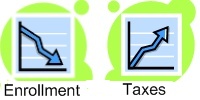
The Post Star has an article on the recent deliberations by the school board on next year’s budget.
You can read the Post Star article here.
While it’s nice to learn that the school board is taking some steps to control next year’s budget, the entire story still leads to more local stagnation.
Local property taxes still go up under next year’s budget, enrollment is projected to fall again (per student spending continues to rise), and funds will be moved from reserve accounts to balance the budget. At the end of the day, the school district is working on a proposed budget of $13,205,125 for approximately 750 students!
To put this in context, calculated on a per-student basis, this approaches or exceeds the tuition for many elite private schools across the country. However, Whitehall is ranked as one of the lower performing schools in the state. Because the school district’s enrollment has declined, and is predicted to decline further in the future, this should be the perfect time to be cutting spending and property taxes.
An easy way to look at a school’s enrollment is to take the students graduating from high school and see if the pre-school/kindergarten enrollment for the next year matches, falls below, or exceeds the number graduating.
A hypothetical example follows. Take a school where 120 students graduate and 60 students enter for a number of years. As time goes by, instead of needing roughly six classes per grade (calculated at 20 students per class) only three classes per grade would be necessary to accommodate the lower enrollment. The class size of 20 students per class though would stay the same.
If managed properly, the number of classes per grade fall as the overall enrollment declines and the younger grades graduate to the next level. Once again, if instituted correctly, the number of classes shrink as the lower grades move up through the school.
However, public sentiment can be manipulated if proposals are made to cut classes in grades with higher enrollment. Take the hypothetical example above; if you told the parents in a grade with 120 students, that half the teachers in that grade would be eliminated, and class sizes were going to jump to 40 students per class, there would be a public outcry.
If managed improperly, there are wild differences in class size and the number of classes by grade. Public sentiment can be easily swayed with arguments over increased class size.
Sadly Whitehall’s destruction of its tax base is noticeable by all; businesses have left, houses sit on the market unsold, people leave for jobs elsewhere. So while we’re paying property taxes like our local district is an elite private school, we’re dealing with one of the lowest ranked districts in the state. The numbers tell a story. Throwing money at the problem has been shown not to work. The only way to turn things around is to cut property taxes. Until the school board learns that lesson, Whitehall’s demise will sadly continue.
